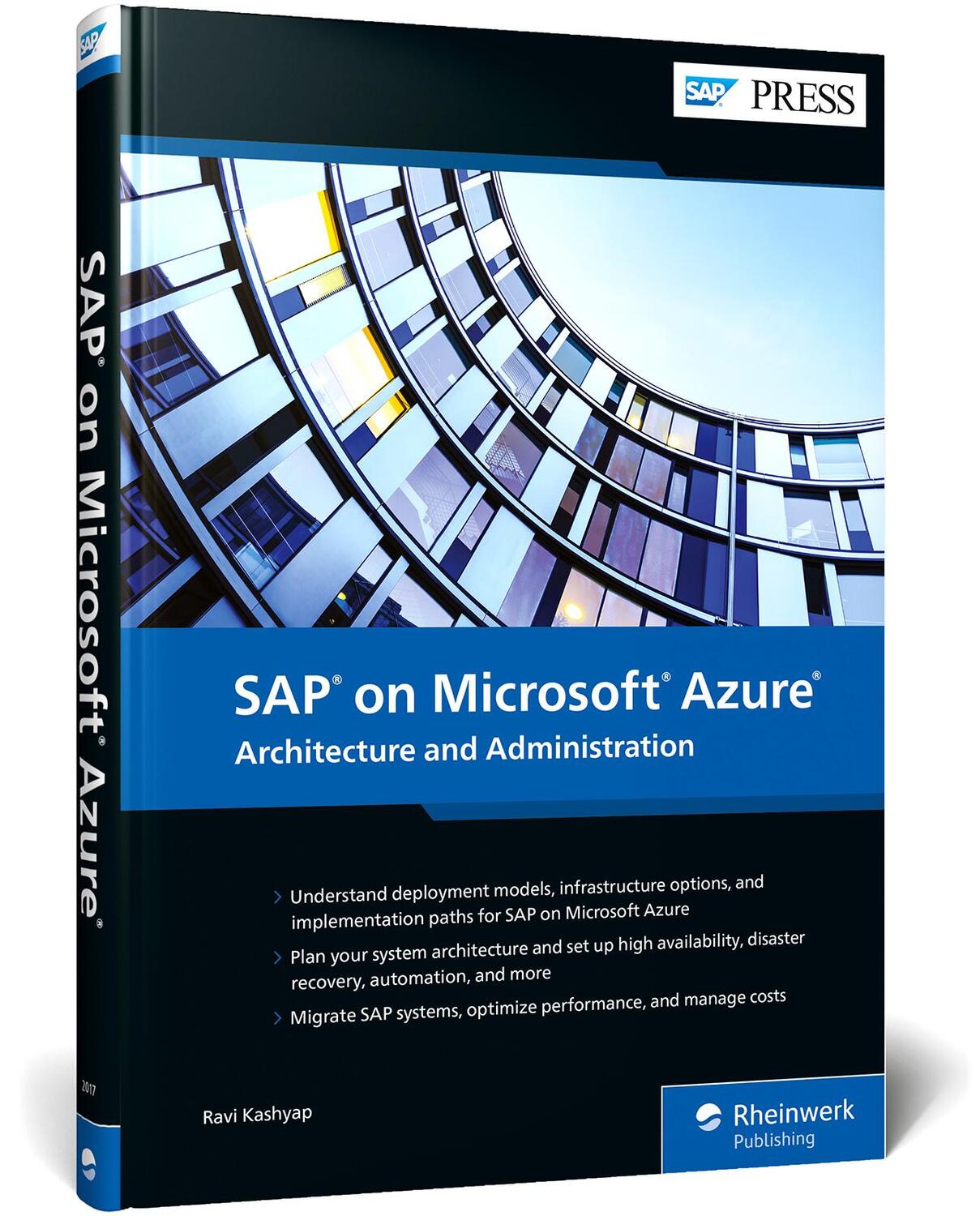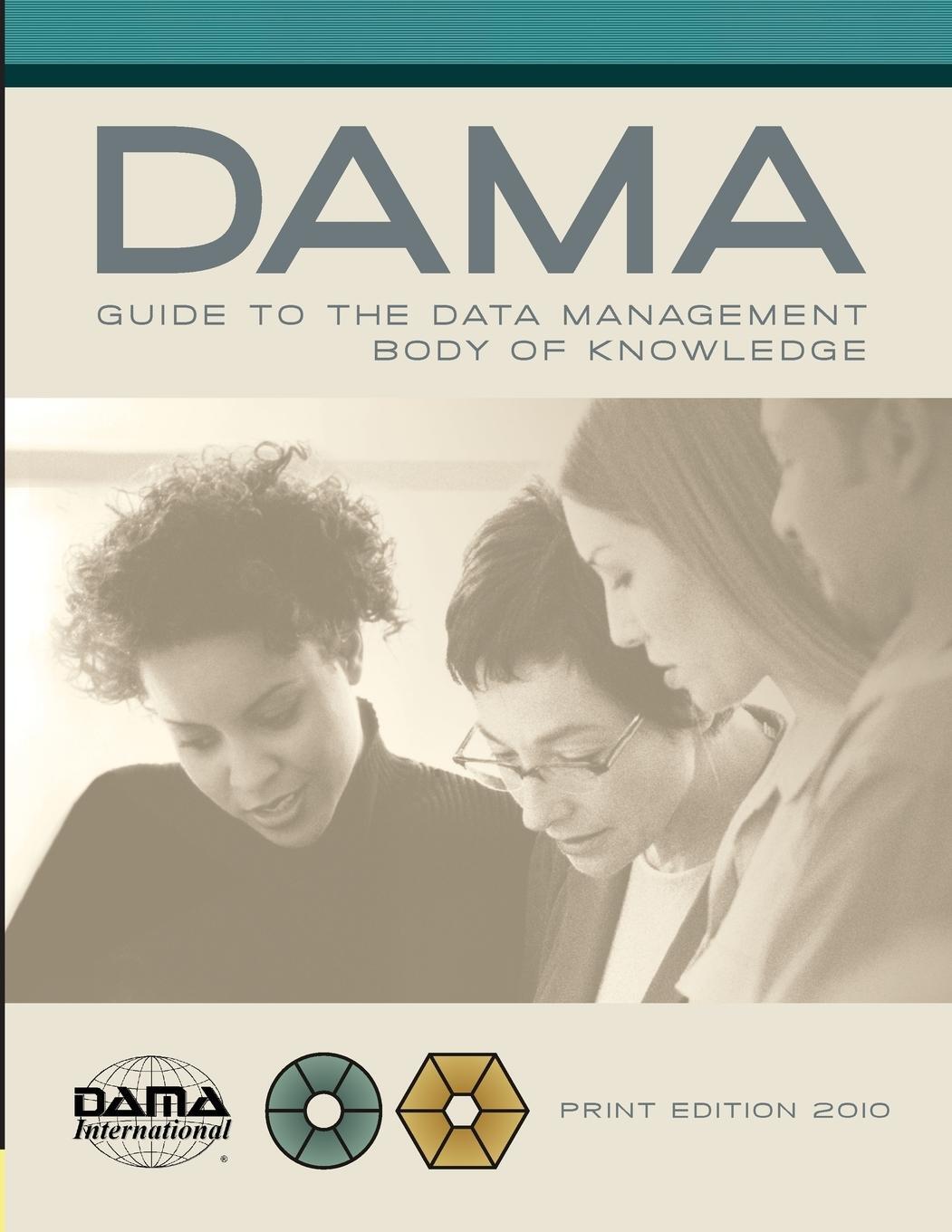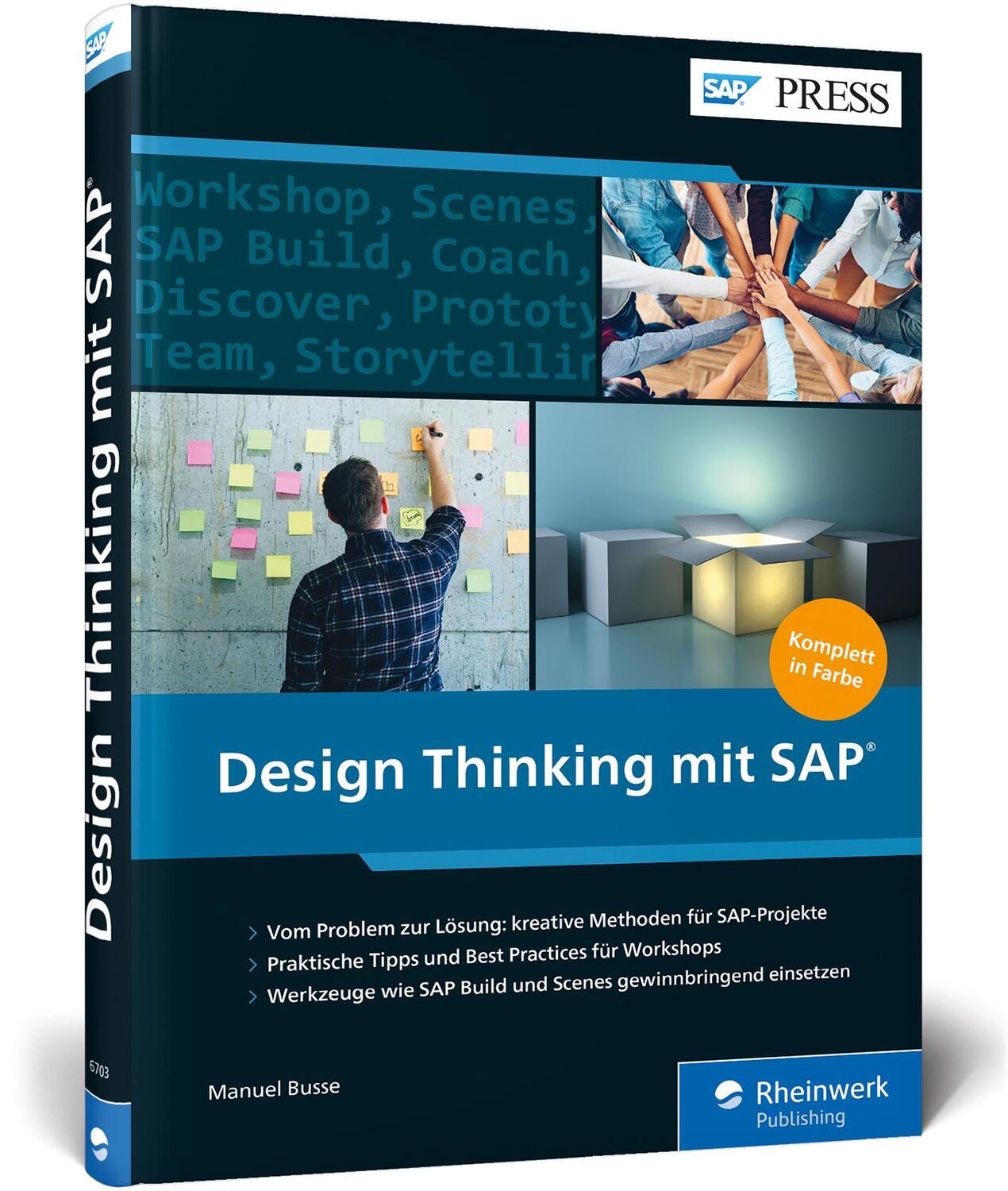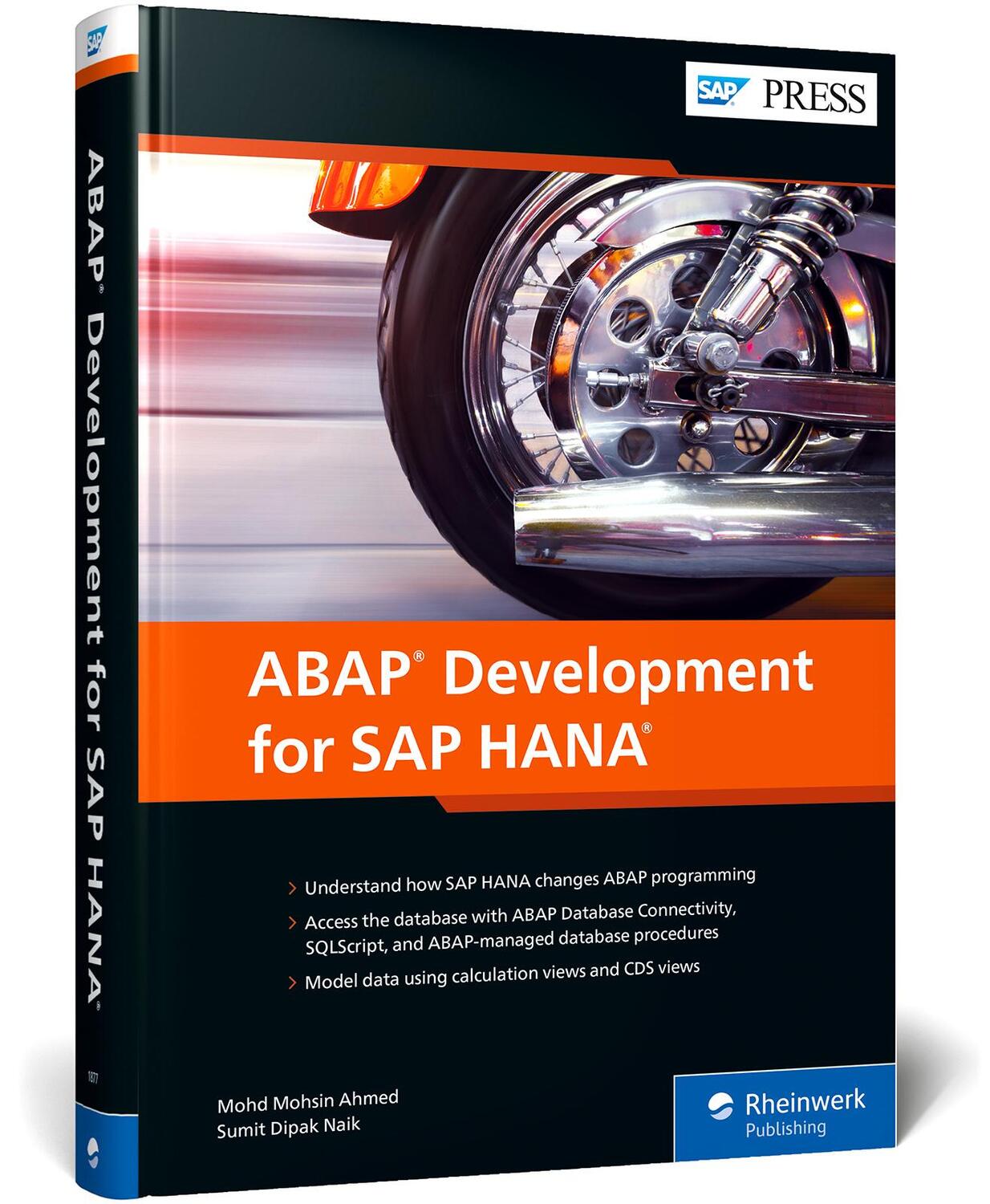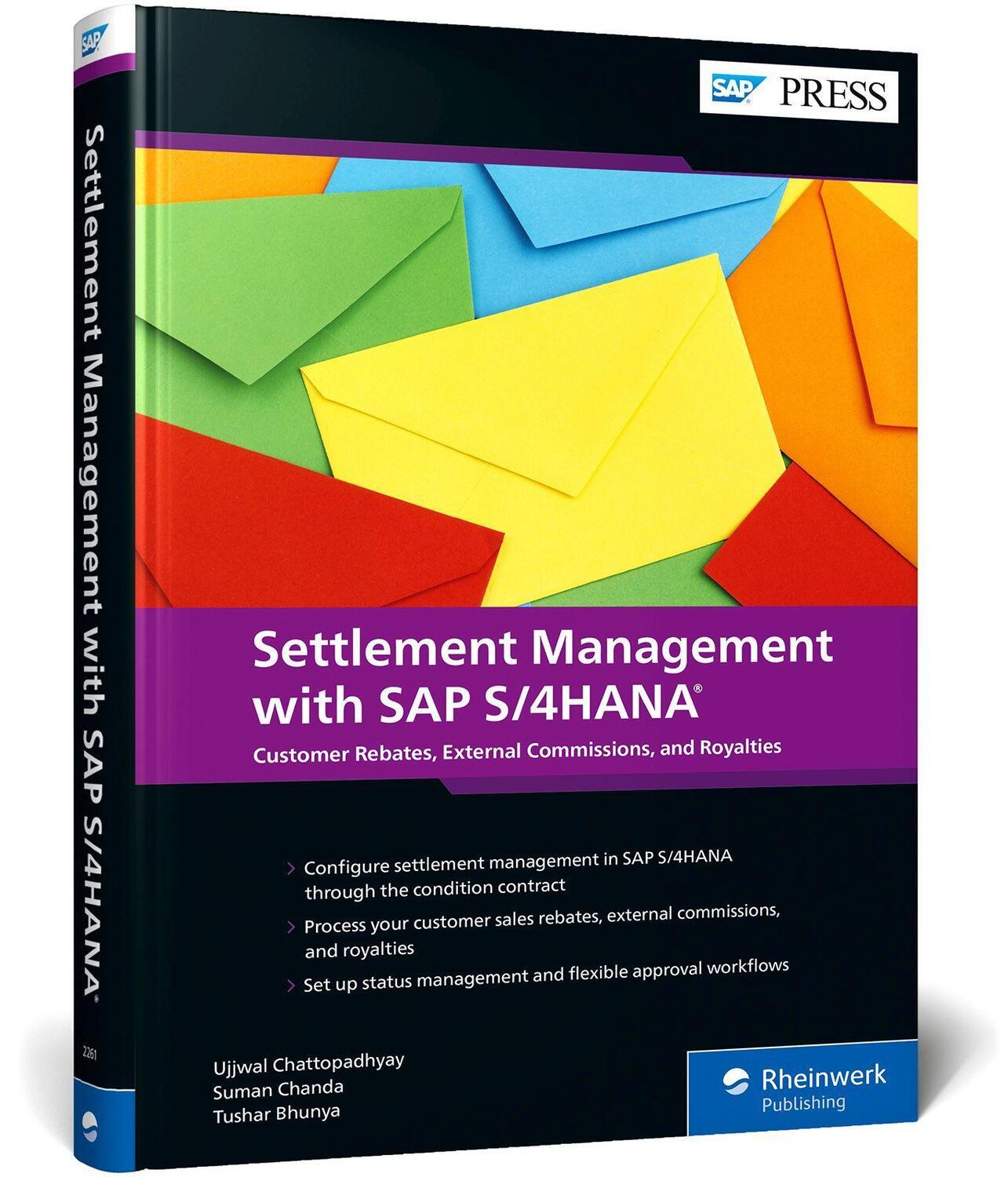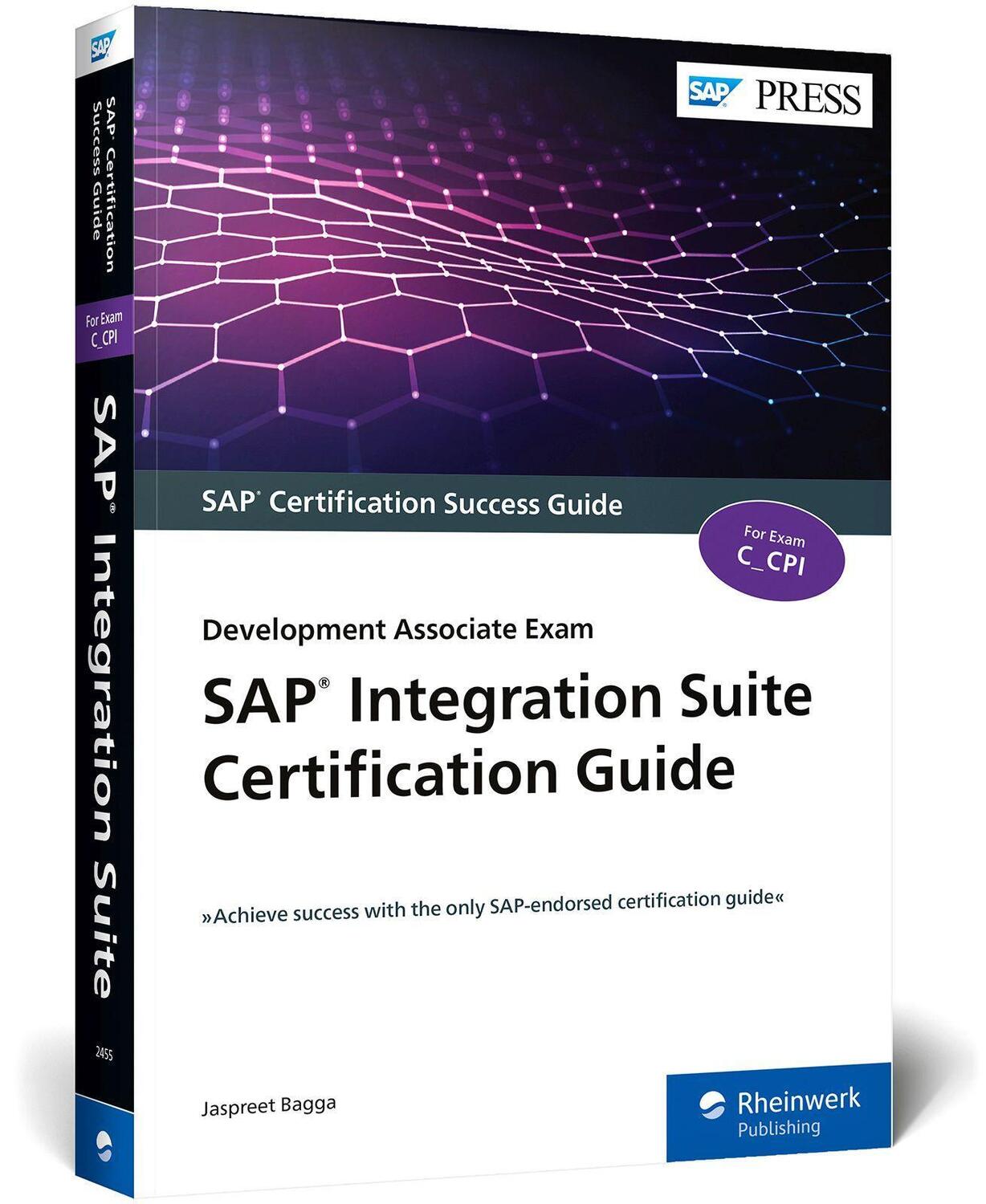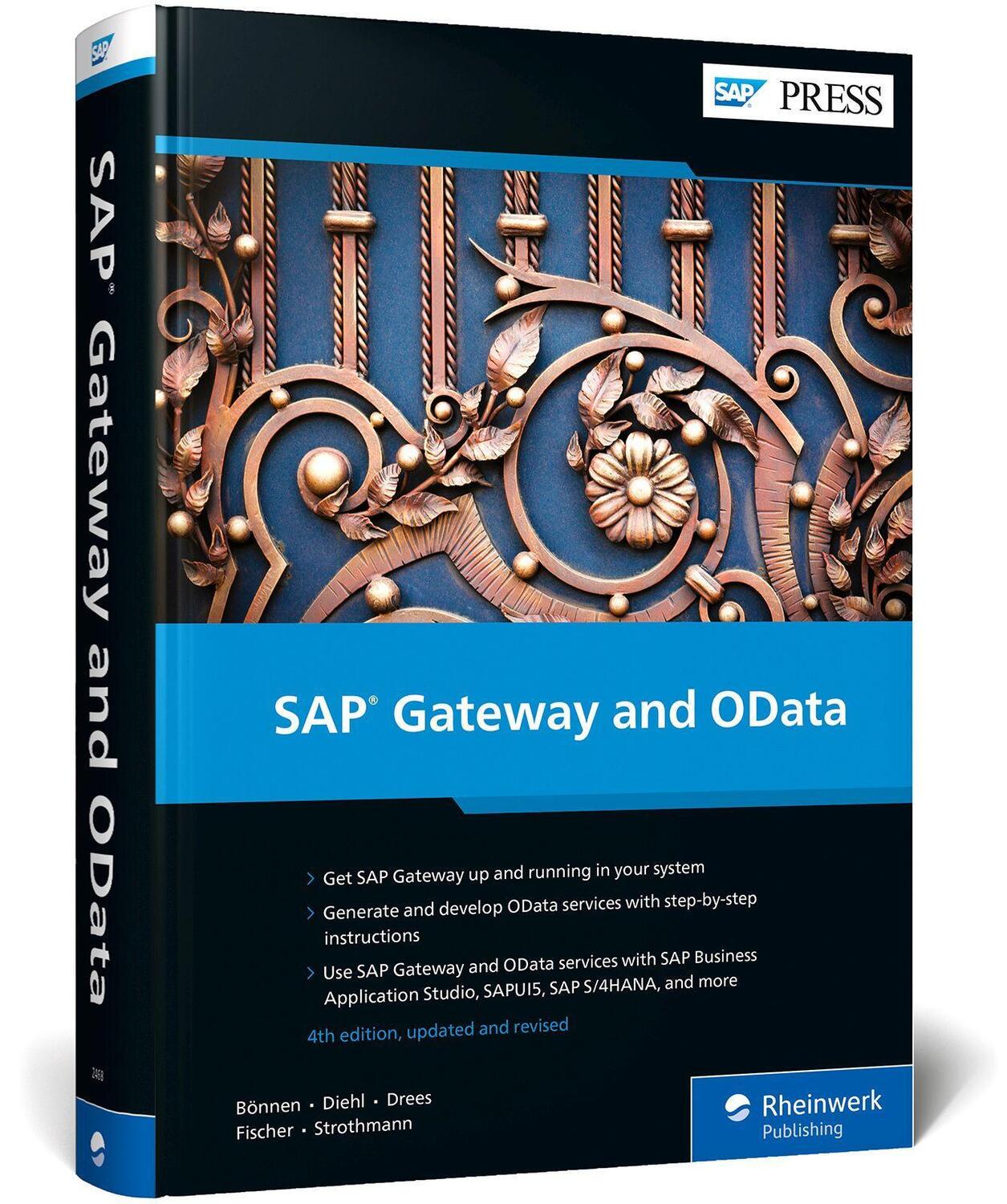80,00 €*
Versandkostenfrei per Post / DHL
Aktuell nicht verfügbar
Run your SAP system on Microsoft Azure with this guide to architecture design and system administration! Get to know Microsoft Azure and its prerequisites, service options, and supported SAP products. Plan and build your system to last with high availability and disaster recovery, and then see how to migrate and operate your system once it's live. Learn to configure and use encryption, backups, automation, compliance, and other key features. Make your cloud project painless!
a. Designing Your System
Begin with design considerations: sizing, availability, security, cost, and more. Then understand Microsoft Azure's architecture and recommended practices for architecture design and service configuration. Walk through network architecture, storage options, and optimizations for your system.
b. Operating Your System
Make sure your system is operating at peak efficiency with tools like SAP Solution Manager and Azure monitor, and keep the bottom line in mind with cost management tools.
c. Protecting Your System
Hope for the best, plan for the worst. Make sure your system can run without significant downtime (high availability) and can be restored in the event of failure (disaster recovery). Leverage backup mechanisms, shared storage, and encryption to make your system resilient!
d. Preparing for Migration
Evaluate your migration readiness, preview the states of any migration project, and begin planning your migration.
1) Architecture
2) Deployment models and infrastructure
3) High availability and disaster recovery
4) Automation
5) Encryption
6) Governance and compliance
7) Backup and recovery
8) Migration
9) Operations and monitoring
10) Case studies
Run your SAP system on Microsoft Azure with this guide to architecture design and system administration! Get to know Microsoft Azure and its prerequisites, service options, and supported SAP products. Plan and build your system to last with high availability and disaster recovery, and then see how to migrate and operate your system once it's live. Learn to configure and use encryption, backups, automation, compliance, and other key features. Make your cloud project painless!
a. Designing Your System
Begin with design considerations: sizing, availability, security, cost, and more. Then understand Microsoft Azure's architecture and recommended practices for architecture design and service configuration. Walk through network architecture, storage options, and optimizations for your system.
b. Operating Your System
Make sure your system is operating at peak efficiency with tools like SAP Solution Manager and Azure monitor, and keep the bottom line in mind with cost management tools.
c. Protecting Your System
Hope for the best, plan for the worst. Make sure your system can run without significant downtime (high availability) and can be restored in the event of failure (disaster recovery). Leverage backup mechanisms, shared storage, and encryption to make your system resilient!
d. Preparing for Migration
Evaluate your migration readiness, preview the states of any migration project, and begin planning your migration.
1) Architecture
2) Deployment models and infrastructure
3) High availability and disaster recovery
4) Automation
5) Encryption
6) Governance and compliance
7) Backup and recovery
8) Migration
9) Operations and monitoring
10) Case studies
... Objective of This Book ... 17
... Target Audience ... 17
... Structure of the Book ... 18
... Acknowledgments ... 20
1 ... Introduction to Microsoft Azure ... 21
1.1 ... What Is Microsoft Azure? ... 21
1.2 ... Cloud Deployment Options ... 22
1.3 ... Cloud Models: Comparing IaaS, PaaS, and SaaS ... 23
1.4 ... Cloud Adoption Framework ... 26
1.5 ... Service Availability and Preview Features ... 28
1.6 ... Understanding Microsoft Azure's SLAs ... 29
1.7 ... Why Move to Microsoft Azure? ... 32
1.8 ... Summary ... 34
2 ... SAP on Microsoft Azure ... 35
2.1 ... The Unique SAP Architecture on Microsoft Azure ... 35
2.2 ... SAP on Microsoft Azure Support Prerequisites ... 36
2.3 ... Supported SAP Products, Databases, and Operating Systems ... 37
2.4 ... SAP Technology Stacks and Architecture ... 40
2.5 ... SAP on Microsoft Azure Reference Architecture ... 42
2.6 ... Deployment Models ... 43
2.7 ... Paths to Microsoft Azure ... 45
2.8 ... SAP Cloud Appliance Library ... 49
2.9 ... Relevant SAP Notes ... 56
2.10 ... Summary ... 57
3 ... Microsoft Azure Infrastructure Offerings for SAP ... 59
3.1 ... Microsoft Azure Enterprise Enrollment Hierarchy ... 59
3.2 ... Connectivity to Microsoft Azure ... 60
3.3 ... Microsoft Azure Pricing Calculator and Total Cost of Ownership Calculator ... 62
3.4 ... Infrastructure Foundation Pillars ... 64
3.5 ... Shared Storage ... 73
3.6 ... Operating System Licenses in Microsoft Azure ... 75
3.7 ... Platform Maintenance and Notifications ... 77
3.8 ... Microsoft Azure Dedicated Host ... 78
3.9 ... SAP HANA on Azure (Large Instances) ... 80
3.10 ... Key Vault ... 82
3.11 ... Microsoft Azure Landing Zone ... 82
3.12 ... Summary ... 83
4 ... System Design Framework ... 85
4.1 ... Security ... 85
4.2 ... Performance ... 93
4.3 ... Resiliency ... 101
4.4 ... Operational Efficiency ... 109
4.5 ... Summary ... 113
5 ... Governance and Compliance ... 115
5.1 ... Policies ... 116
5.2 ... Management Groups ... 117
5.3 ... Resource Groups ... 118
5.4 ... Role-Based Access Control ... 119
5.5 ... Naming Conventions ... 121
5.6 ... Resource Locks ... 122
5.7 ... Tagging ... 123
5.8 ... Microsoft Azure Blueprint ... 124
5.9 ... Regulatory and Audit Compliance ... 125
5.10 ... Summary ... 128
6 ... Infrastructure Architecture Guidance ... 129
6.1 ... Microsoft Azure Regions ... 129
6.2 ... Subscription Design ... 130
6.3 ... Connectivity and Network Design ... 131
6.4 ... Compute ... 136
6.5 ... Storage ... 139
6.6 ... Summary ... 140
7 ... Resiliency ... 141
7.1 ... High Availability ... 141
7.2 ... Disaster Recovery ... 162
7.3 ... Reference Architecture ... 171
7.4 ... Summary ... 173
8 ... Backup Architecture and Mechanisms ... 175
8.1 ... Backup and Restore Overview ... 175
8.2 ... Backup Classifications ... 177
8.3 ... Microsoft Azure Backup and Recovery Vault ... 178
8.4 ... Virtual Machine Backup ... 178
8.5 ... Database Backup ... 180
8.6 ... Shared Disk Backup ... 185
8.7 ... Third-Party Tools ... 185
8.8 ... Backup and Retention Policy ... 186
8.9 ... Restore and Recovery ... 187
8.10 ... Management and Reporting ... 190
8.11 ... Summary ... 191
9 ... Automation ... 193
9.1 ... Infrastructure as Code ... 194
9.2 ... Automation Use Cases ... 195
9.3 ... Automation Tools ... 197
9.4 ... DevOps Integration ... 203
9.5 ... Quickstart Templates ... 203
9.6 ... Disadvantages of Using Automation ... 204
9.7 ... Automation Recommend Practices ... 205
9.8 ... Summary ... 206
10 ... Encryption ... 207
10.1 ... Encryption at Rest ... 207
10.2 ... Encryption in Transit ... 211
10.3 ... Key Management ... 212
10.4 ... Summary ... 212
11 ... Migrating SAP to Microsoft Azure ... 213
11.1 ... Planning and Readiness ... 213
11.2 ... Migration Paths and Methodologies ... 215
11.3 ... Large Databases and Migration Optimizations ... 226
11.4 ... SAP Landscape Migration Phases ... 231
11.5 ... Lessons Learned ... 236
11.6 ... Summary ... 238
12 ... Operations ... 239
12.1 ... Cloud Operating Model ... 239
12.2 ... Operational Efficiency ... 240
12.3 ... Monitoring ... 257
12.4 ... Cost Management ... 268
12.5 ... Summary ... 275
13 ... Case Study ... 277
13.1 ... New Implementation Planning ... 277
13.2 ... Migration Planning ... 282
13.3 ... Summary ... 285
14 ... Outlook ... 287
14.1 ... Marching towards SAP S/4HANA ... 287
14.2 ... Integration to Cloud Native Tools ... 287
14.3 ... SAP Innovations ... 288
14.4 ... Evolution of Microsoft Azure ... 289
14.5 ... Containers for SAP? ... 290
14.6 ... Summary ... 291
... The Author ... 293
... Index ... 295
| Erscheinungsjahr: | 2021 |
|---|---|
| Fachbereich: | Datenkommunikation, Netze & Mailboxen |
| Genre: | Informatik |
| Rubrik: | Naturwissenschaften & Technik |
| Medium: | Buch |
| Seiten: | 301 |
| Inhalt: | 301 S. |
| ISBN-13: | 9781493220175 |
| ISBN-10: | 1493220179 |
| Sprache: | Englisch |
| Herstellernummer: | 459/22017 |
| Einband: | Gebunden |
| Autor: | Kashyap, Ravi |
| Hersteller: |
Rheinwerk Publishing
Rheinwerk Publishing, Inc. |
| Maße: | 261 x 187 x 26 mm |
| Von/Mit: | Ravi Kashyap |
| Erscheinungsdatum: | 26.01.2021 |
| Gewicht: | 0,798 kg |
... Objective of This Book ... 17
... Target Audience ... 17
... Structure of the Book ... 18
... Acknowledgments ... 20
1 ... Introduction to Microsoft Azure ... 21
1.1 ... What Is Microsoft Azure? ... 21
1.2 ... Cloud Deployment Options ... 22
1.3 ... Cloud Models: Comparing IaaS, PaaS, and SaaS ... 23
1.4 ... Cloud Adoption Framework ... 26
1.5 ... Service Availability and Preview Features ... 28
1.6 ... Understanding Microsoft Azure's SLAs ... 29
1.7 ... Why Move to Microsoft Azure? ... 32
1.8 ... Summary ... 34
2 ... SAP on Microsoft Azure ... 35
2.1 ... The Unique SAP Architecture on Microsoft Azure ... 35
2.2 ... SAP on Microsoft Azure Support Prerequisites ... 36
2.3 ... Supported SAP Products, Databases, and Operating Systems ... 37
2.4 ... SAP Technology Stacks and Architecture ... 40
2.5 ... SAP on Microsoft Azure Reference Architecture ... 42
2.6 ... Deployment Models ... 43
2.7 ... Paths to Microsoft Azure ... 45
2.8 ... SAP Cloud Appliance Library ... 49
2.9 ... Relevant SAP Notes ... 56
2.10 ... Summary ... 57
3 ... Microsoft Azure Infrastructure Offerings for SAP ... 59
3.1 ... Microsoft Azure Enterprise Enrollment Hierarchy ... 59
3.2 ... Connectivity to Microsoft Azure ... 60
3.3 ... Microsoft Azure Pricing Calculator and Total Cost of Ownership Calculator ... 62
3.4 ... Infrastructure Foundation Pillars ... 64
3.5 ... Shared Storage ... 73
3.6 ... Operating System Licenses in Microsoft Azure ... 75
3.7 ... Platform Maintenance and Notifications ... 77
3.8 ... Microsoft Azure Dedicated Host ... 78
3.9 ... SAP HANA on Azure (Large Instances) ... 80
3.10 ... Key Vault ... 82
3.11 ... Microsoft Azure Landing Zone ... 82
3.12 ... Summary ... 83
4 ... System Design Framework ... 85
4.1 ... Security ... 85
4.2 ... Performance ... 93
4.3 ... Resiliency ... 101
4.4 ... Operational Efficiency ... 109
4.5 ... Summary ... 113
5 ... Governance and Compliance ... 115
5.1 ... Policies ... 116
5.2 ... Management Groups ... 117
5.3 ... Resource Groups ... 118
5.4 ... Role-Based Access Control ... 119
5.5 ... Naming Conventions ... 121
5.6 ... Resource Locks ... 122
5.7 ... Tagging ... 123
5.8 ... Microsoft Azure Blueprint ... 124
5.9 ... Regulatory and Audit Compliance ... 125
5.10 ... Summary ... 128
6 ... Infrastructure Architecture Guidance ... 129
6.1 ... Microsoft Azure Regions ... 129
6.2 ... Subscription Design ... 130
6.3 ... Connectivity and Network Design ... 131
6.4 ... Compute ... 136
6.5 ... Storage ... 139
6.6 ... Summary ... 140
7 ... Resiliency ... 141
7.1 ... High Availability ... 141
7.2 ... Disaster Recovery ... 162
7.3 ... Reference Architecture ... 171
7.4 ... Summary ... 173
8 ... Backup Architecture and Mechanisms ... 175
8.1 ... Backup and Restore Overview ... 175
8.2 ... Backup Classifications ... 177
8.3 ... Microsoft Azure Backup and Recovery Vault ... 178
8.4 ... Virtual Machine Backup ... 178
8.5 ... Database Backup ... 180
8.6 ... Shared Disk Backup ... 185
8.7 ... Third-Party Tools ... 185
8.8 ... Backup and Retention Policy ... 186
8.9 ... Restore and Recovery ... 187
8.10 ... Management and Reporting ... 190
8.11 ... Summary ... 191
9 ... Automation ... 193
9.1 ... Infrastructure as Code ... 194
9.2 ... Automation Use Cases ... 195
9.3 ... Automation Tools ... 197
9.4 ... DevOps Integration ... 203
9.5 ... Quickstart Templates ... 203
9.6 ... Disadvantages of Using Automation ... 204
9.7 ... Automation Recommend Practices ... 205
9.8 ... Summary ... 206
10 ... Encryption ... 207
10.1 ... Encryption at Rest ... 207
10.2 ... Encryption in Transit ... 211
10.3 ... Key Management ... 212
10.4 ... Summary ... 212
11 ... Migrating SAP to Microsoft Azure ... 213
11.1 ... Planning and Readiness ... 213
11.2 ... Migration Paths and Methodologies ... 215
11.3 ... Large Databases and Migration Optimizations ... 226
11.4 ... SAP Landscape Migration Phases ... 231
11.5 ... Lessons Learned ... 236
11.6 ... Summary ... 238
12 ... Operations ... 239
12.1 ... Cloud Operating Model ... 239
12.2 ... Operational Efficiency ... 240
12.3 ... Monitoring ... 257
12.4 ... Cost Management ... 268
12.5 ... Summary ... 275
13 ... Case Study ... 277
13.1 ... New Implementation Planning ... 277
13.2 ... Migration Planning ... 282
13.3 ... Summary ... 285
14 ... Outlook ... 287
14.1 ... Marching towards SAP S/4HANA ... 287
14.2 ... Integration to Cloud Native Tools ... 287
14.3 ... SAP Innovations ... 288
14.4 ... Evolution of Microsoft Azure ... 289
14.5 ... Containers for SAP? ... 290
14.6 ... Summary ... 291
... The Author ... 293
... Index ... 295
| Erscheinungsjahr: | 2021 |
|---|---|
| Fachbereich: | Datenkommunikation, Netze & Mailboxen |
| Genre: | Informatik |
| Rubrik: | Naturwissenschaften & Technik |
| Medium: | Buch |
| Seiten: | 301 |
| Inhalt: | 301 S. |
| ISBN-13: | 9781493220175 |
| ISBN-10: | 1493220179 |
| Sprache: | Englisch |
| Herstellernummer: | 459/22017 |
| Einband: | Gebunden |
| Autor: | Kashyap, Ravi |
| Hersteller: |
Rheinwerk Publishing
Rheinwerk Publishing, Inc. |
| Maße: | 261 x 187 x 26 mm |
| Von/Mit: | Ravi Kashyap |
| Erscheinungsdatum: | 26.01.2021 |
| Gewicht: | 0,798 kg |

